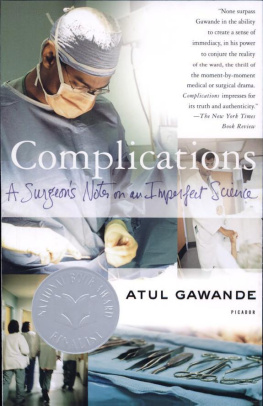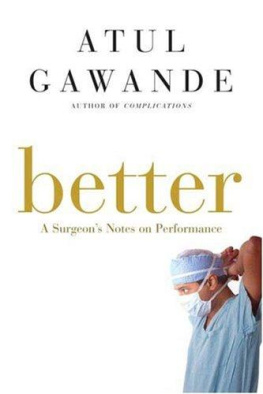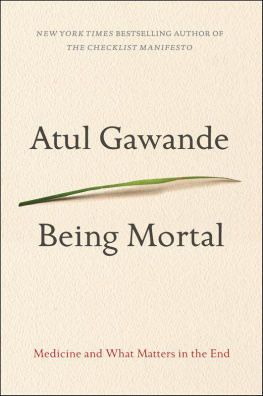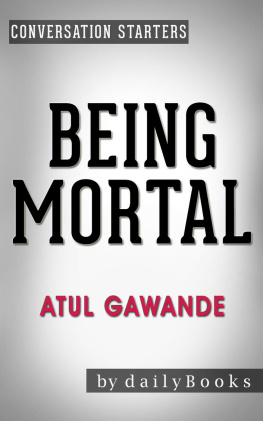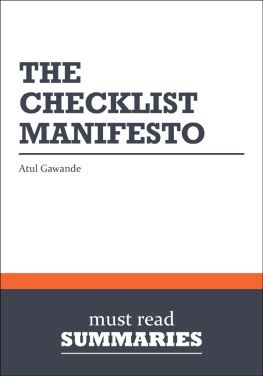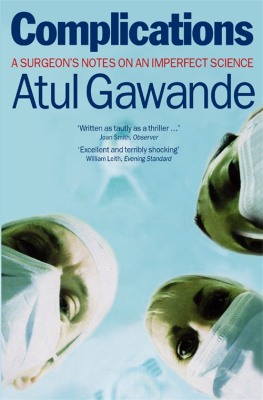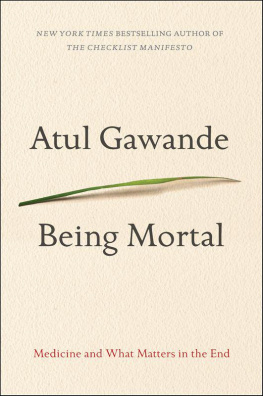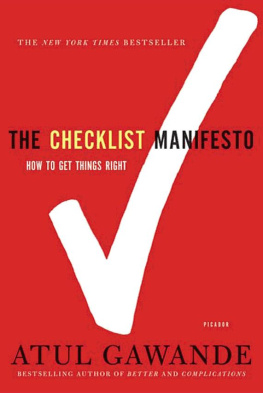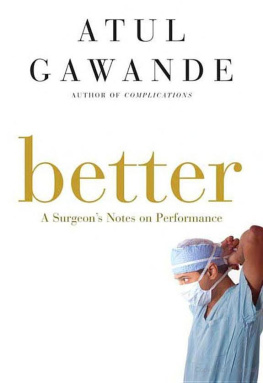Atul Gawande - The checklist manifesto: how to get things right
Here you can read online Atul Gawande - The checklist manifesto: how to get things right full text of the book (entire story) in english for free. Download pdf and epub, get meaning, cover and reviews about this ebook. City: London, year: 2011, publisher: Profile Books Ltd, genre: Detective and thriller. Description of the work, (preface) as well as reviews are available. Best literature library LitArk.com created for fans of good reading and offers a wide selection of genres:
Romance novel
Science fiction
Adventure
Detective
Science
History
Home and family
Prose
Art
Politics
Computer
Non-fiction
Religion
Business
Children
Humor
Choose a favorite category and find really read worthwhile books. Enjoy immersion in the world of imagination, feel the emotions of the characters or learn something new for yourself, make an fascinating discovery.

- Book:The checklist manifesto: how to get things right
- Author:
- Publisher:Profile Books Ltd
- Genre:
- Year:2011
- City:London
- Rating:4 / 5
- Favourites:Add to favourites
- Your mark:
- 80
- 1
- 2
- 3
- 4
- 5
The checklist manifesto: how to get things right: summary, description and annotation
We offer to read an annotation, description, summary or preface (depends on what the author of the book "The checklist manifesto: how to get things right" wrote himself). If you haven't found the necessary information about the book — write in the comments, we will try to find it.
The checklist manifesto: how to get things right — read online for free the complete book (whole text) full work
Below is the text of the book, divided by pages. System saving the place of the last page read, allows you to conveniently read the book "The checklist manifesto: how to get things right" online for free, without having to search again every time where you left off. Put a bookmark, and you can go to the page where you finished reading at any time.
Font size:
Interval:
Bookmark:
ALSO BY ATUL GAWANDE
BETTER: A SURGEONS NOTES ON PERFORMANCE
COMPLICATIONS: A SURGEONS NOTES ON AN IMPERFECT SCIENCE
THE CHECKLIST MANIFESTO
ATUL GAWANDE
THE CHECKLIST MANIFESTO HOW TO GET THINGS RIGHT

First published in Great Britain in 2010 by
PROFILE BOOKS LTD
3A Exmouth House
Pine Street
London EC1R 0JH
www.profilebooks.com
First published in America in 2009 by
Metropolitan Books of Henry Holt and Company LLC
Copyright Atul Gawande, 2010
Some material in this book originally appeared
in the New Yorker essay, The Checklist in different form
1 2 3 4 5 6 7 9 10
Printed and bound in Great Britain by
Clays, Bungay, Suffolk
The moral right of the author has been asserted.
All rights reserved. Without limiting the rights under copyright reserved above, no part of this publication may be reproduced, stored or introduced into a retrieval system, or transmitted, in any form or by any means (electronic, mechanical, photocopying, recording or otherwise), without the prior written permission of both the copyright owner and the publisher of this book.
A CIP catalogue record for this book is available from the British Library.
eISBN: 978-1-84765-187-7
The paper this book is printed on is certified by the 1996 Forest Stewardship Council A.C. (FSC). It is ancient-forest friendly. The printer holds FSC chain of custody SGS-COC-2061

For Hunter, Hattie, and Walker
CONTENTS
THE CHECKLIST MANIFESTO
I was chatting with a medical school friend of mine who is now a general surgeon in San Francisco. We were trading war stories, as surgeons are apt to do. One of Johns was about a guy who came in on Halloween night with a stab wound. He had been at a costume party. He got into an altercation. And now here he was.
He was stable, breathing normally, not in pain, just drunk and babbling to the trauma team. They cut off his clothes with shears and looked him over from head to toe, front and back. He was of moderate size, about two hundred pounds, most of the excess around his middle. That was where they found the stab wound, a neat two-inch red slit in his belly, pouting open like a fish mouth. A thin mustard yellow strip of omental fat tongued out of itfat from inside his abdomen, not the pale yellow, superficial fat that lies beneath the skin. Theyd need to take him to the operating room, check to make sure the bowel wasnt injured, and sew up the little gap.
No big deal, John said.
If it were a bad injury, theyd need to crash into the operating roomstretcher flying, nurses racing to get the surgical equipment set up, the anesthesiologists skipping their detailed review of the medical records. But this was not a bad injury. They had time, they determined. The patient lay waiting on his stretcher in the stucco-walled trauma bay while the OR was readied.
Then a nurse noticed hed stopped babbling. His heart rate had skyrocketed. His eyes were rolling back in his head. He didnt respond when she shook him. She called for help, and the members of the trauma team swarmed back into the room. His blood pressure was barely detectible. They stuck a tube down his airway and pushed air into his lungs, poured fluid and emergency-release blood into him. Still they couldnt get his pressure up.
So now they were crashing into the operating roomstretcher flying, nurses racing to get the surgical equipment set up, the anesthesiologists skipping their review of the records, a resident splashing a whole bottle of Betadine antiseptic onto his belly, John grabbing a fat No. 10 blade and slicing down through the skin of the mans abdomen in one clean, determined swipe from rib cage to pubis.
Cautery.
He drew the electrified metal tip of the cautery pen along the fat underneath the skin, parting it in a line from top to bottom, then through the fibrous white sheath of fascia between the abdominal muscles. He pierced his way into the abdominal cavity itself, and suddenly an ocean of blood burst out of the patient.
Crap.
The blood was everywhere. The assailants knife had gone more than a foot through the mans skin, through the fat, through the muscle, past the intestine, along the left of his spinal column, and right into the aorta, the main artery from the heart.
Which was crazy, John said. Another surgeon joined to help and got a fist down on the aorta, above the puncture point. That stopped the worst of the bleeding and they began to get control of the situation. Johns colleague said he hadnt seen an injury like it since Vietnam.
The description was pretty close, it turned out. The other guy at the costume party, John later learned, was dressed as a soldierwith a bayonet.
The patient was touch and go for a couple days. But he pulled through. John still shakes his head ruefully when he talks about the case.
There are a thousand ways that things can go wrong when youve got a patient with a stab wound. But everyone involved got almost every step rightthe head-to-toe examination, the careful tracking of the patients blood pressure and pulse and rate of breathing, the monitoring of his consciousness, the fluids run in by IV, the call to the blood bank to have blood ready, the placement of a urinary catheter to make sure his urine was running clear, everything. Except no one remembered to ask the patient or the emergency medical technicians what the weapon was.
Your mind doesnt think of a bayonet in San Francisco, John could only say.
He told me about another patient, who was undergoing an operation to remove a cancer of his stomach when his heart suddenly stopped.* John remembered looking up at the cardiac monitor and saying to the anesthesiologist, Hey, is that asystole? Asystole is total cessation of heart function. It looks like a flat line on the monitor, as if the monitor is not even hooked up to the patient.
The anesthesiologist said, A lead must have fallen off, because it seemed impossible to believe that the patients heart had stopped. The man was in his late forties and had been perfectly healthy. The tumor was found almost by chance. He had gone to see his physician about something else, a cough perhaps, and mentioned hed been having some heartburn, too. Well, not heartburn exactly. He felt like food sometimes got stuck in his esophagus and wouldnt go down and that gave him heartburn. The doctor ordered an imaging test that required him to swallow a milky barium drink while standing in front of an X-ray machine. And there on the images it was: a fleshy mouse-size mass, near the top of the stomach, intermittently pressing up against the entrance like a stopper. It had been caught early. There were no signs of spread. The only known cure was surgery, in this case a total gastrectomy, meaning removal of his entire stomach, a major four-hour undertaking.
The team members were halfway through the procedure. The cancer was out. Thered been no problems whatsoever. They were getting ready to reconstruct the patients digestive tract when the monitor went flat-line. It took them about five seconds to figure out that a lead had not fallen off. The anesthesiologist could feel no pulse in the patients carotid artery. His heart had stopped.
John tore the sterile drapes off the patient and started doing chest compressions, the patients intestines bulging in and out of his open abdomen with each push. A nurse called a Code Blue.
John paused here in telling the story and asked me to suppose I was in his situation. So, now, what would you do?
Font size:
Interval:
Bookmark:
Similar books «The checklist manifesto: how to get things right»
Look at similar books to The checklist manifesto: how to get things right. We have selected literature similar in name and meaning in the hope of providing readers with more options to find new, interesting, not yet read works.
Discussion, reviews of the book The checklist manifesto: how to get things right and just readers' own opinions. Leave your comments, write what you think about the work, its meaning or the main characters. Specify what exactly you liked and what you didn't like, and why you think so.

